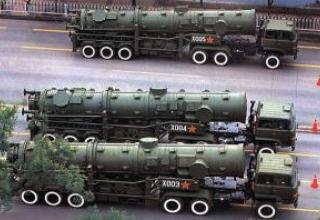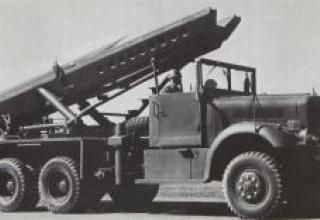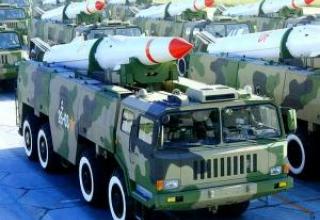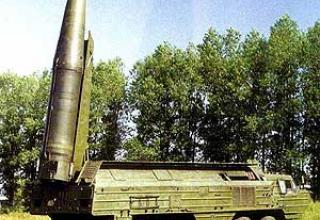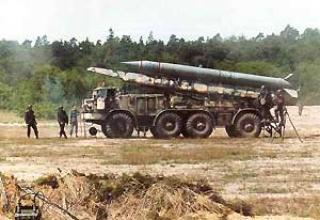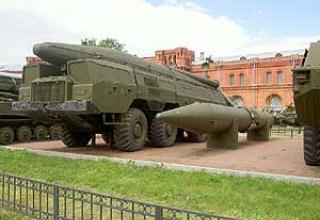By the mid-70s, the United States returned to the creation of medium-range ballistic missiles. This was due to a change in the military and political balance with the USSR. The real opportunity to receive a powerful retaliatory strike on its territory forced American strategists and politicians to look for an acceptable way out of this situation. The concept of "limited nuclear war" was developed, the essence of which was to transfer the nuclear conflict zone to Europe, with the capture of the Soviet Union as well. In 1972, theoretical studies on this problem began, which allowed to develop a set of tactical and technical requirements for the future missile system.
Since the mid-70s, a number of missile companies have been conducting research and development work on the complex. The victory was won by Martin-Marietta Aerospace, with which the contract for full-scale development was signed in 1979.
The design work was completed by 1982. And in April the rocket, which by that time was called Pershing-2, entered the flight tests. It was planned to conduct 14 control launches and 14 military launches. The first two launches, which took place on June 22 and November 19, ended unsuccessfully. But the designers quickly understood the causes of these failures, and the next 7 test launches at ranges from 100 to 1650 km were successful. A total of 18 test launches were conducted, after which the decision was made to deploy the Pershing-2 missile complex to the 56th US Army Brigade.
Composition:
In its layout scheme, the Pershing-2 was a two-stage rocket with sequential separation of steps docked at the head end by means of transitional compartments (see diagram). A characteristic feature of the rocket is the location of its control system in the head end . and the presence of a thrust cut-off system on both solid fuel stages.
The design of the RDTT (developed by Hercules) of the marching steps was identical and consisted of the following main elements:
- hulls made of composite material based on "Kevlar-49" material with heat-insulating coating,
- a nozzle block rigidly bonded to the solid fuel charge housing,
- of the ignition,
- thrust vector control drives
- of the thrust cut-off systems.
The designers used a slope with an increased degree of expansion, which was deflected by an electrically controlled hydraulic drive. Operating time of engines up to complete burnout of fuel-55 and 40 seconds for the first and second stage, respectively. The use of the thrust cut-off system allowed for a wide range of flight ranges.
The head end consisted of three compartments: front (with BC blast sensors and guidance system elements located in it), middle (combat unit) and rear (inertial control system and its actuators).
The missile's flight control in the active section of the trajectory along the angles of pitch and yaw was carried out by deflecting the RDTT nozzles. The heel control in the first stage engine section was performed by two aerodynamic rudders mounted on the tail section of this stage. The other two rudders, placed there, were fixed rigidly and acted as stabilizers. During the operation of the second stage RTDT, the roll was controlled by four aerodynamic steering wheels on the head end.
The control system was supplemented by a system of guidance of the hC on the final section of the trajectory along the radar map of the terrain (RADAG system). Such a system was not previously used on ballistic missiles. The command instrument complex was located on a stabilized platform, placed in a cylindrical body, and had its own electronic control unit. The operation of the control system was provided by an on-board digital computing system placed in 12 removable modules and protected by an aluminum housing.
The RADAG system consisted of an onboard radar station and a correlator. The radar was shielded and had two antenna blocks. One of them was designed to provide a radar brightness image of the terrain. The other was for determining the flight altitude. The image of ring type under the head part was obtained by scanning around the vertical axis at an angular speed of 2 r/s. Four reference images of the target area for different altitudes were stored in the memory of the DEM in the form of a sensor, each cell of which represented the radar brightness of the corresponding area, recorded by a two-digit binary number. The actual image of the terrain obtained from the radar was reduced to a similar matrix, by comparing it with the reference one could determine the error of the inertial system.
The flight of the head unit was corrected by the executive bodies - jet nozzles operating from a compressed gas cylinder outside the atmosphere, and aerodynamic rudders with hydraulic drive when entering the atmosphere. The missile carried a nuclear monoblock with a variable tratil equivalent as its combat equipment. Before launch, the calculation of the launch control point could choose one of four possible capacities: 0.3, 2, 10, 80 kt. To engage highly protected objects, a nuclear charge penetrating 50-70 m deep into the ground was developed.
The Pershing-2 missile was placed on a launcher mounted on a wheeled semitrailer, and before launch it was in an upright position (see photo). The missile had no transport and launch container and special covers were used to protect it from precipitation, dust and dirt. Prior to launch, it was placed in an upright position. All combat and auxiliary units were mounted on a self-propelled chassis.
Characteristics:
| Range, km | 650 - 1800 |
| Length, m | 10.6 |
| Maximum case diameter, m | 1.02 |
| Start weight,t | 7.4 |
| The power of the combat unit, kt | 0.3, 2, 10, 80 |
| Circular probable deviation,m | 50 |
| Ready to go, seconds. | 30 |
Testing:
In West Germany, 108 launchers (120 missiles) for Pershing-2 missiles were deployed on three missile operating bases. In peacetime, all missiles and equipment were usually in fixed hangars. It was planned to move them to the wooded areas of Bavaria, where the missile batteries took up launch positions and prepared for combat missions. The flight time of Pershing-2 to the objects located in the center of the European part of the USSR was only 8-10 minutes, which made them a very dangerous weapon of the first strike.
Like the Soviet medium-range missiles, the Pershing-2 fell under the DSMD Treaty. All 120 deployed and 127 non-deployed missiles in the US territory were eliminated by the middle of 1991.
There is information about the use of the Pershing-2 control and guidance system in the Hera target missile. It was assembled from the second and third stages of the Minuteman-2 intercontinental missiles removed from combat duty. The U.S. used to take this vehicle off the destructible Pershing-2 missiles and store it. The Pentagon division, the Ballistic Missile Defense Organization, actively uses Hera as a simulator for its two missile defense systems: THAAD and Patriot PAC-3. The Russian military classifies Hera as a medium-range ground-based ballistic missile (BNB). The creation, production and deployment of such weapons is categorically prohibited under the DSM Treaty.
Sources:
- "Международное военное обозрение"
- В. И. Феодосьев "Основы техники ракетного полета"
- "Энциклопедия вооружений"
- "Вашингтон реанимирует "Першинги" Сергей Сокут "





